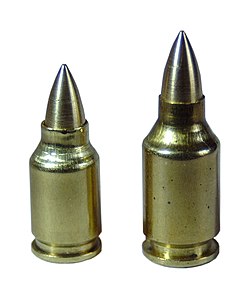British cartridge designed in the 1990s
| .224 Boz |
|---|
 |
| Type | Handgun |
|---|
| Place of origin | United Kingdom |
|---|
|
| Designed | late 1990s |
|---|
| Manufacturer | Civil Defence Supply (United Kingdom) |
|---|
|
| Parent case | 9×19mm Parabellum (originally 10mm Auto) |
|---|
|
|
|
|
| Bullet mass/type |
Velocity |
Energy |
| 45 gr (3 g) |
2,400 ft/s (730 m/s) |
575.44 ft⋅lbf (780.19 J) |
| 50 gr (3 g) |
2,500 ft/s (760 m/s) |
693.77 ft⋅lbf (940.63 J) |
|
| Test barrel length: 5 in (13 cm) |
The .224 Boz cartridge was developed in the late 1990s, designed as a candidate replacement cartridge for adoption as the standardized NATO ("STANAG") Personal defense weapon PDW round, originally solicited to replace the longstanding NATO standard (STANAG) 9×19mm Parabellum. It was going to be the British entry, to be evaluated alongside the Belgian FN 5.7x28mm and the German HK 4.6×30mm armor-piercing cartridges. The solicitation would also seek to find, test and standardize a PDW cartridge capable of, at the minimum, defeating the Collaborative Research Into Small Arms Technology (CRISAT) body armour of the time.[1][2]
